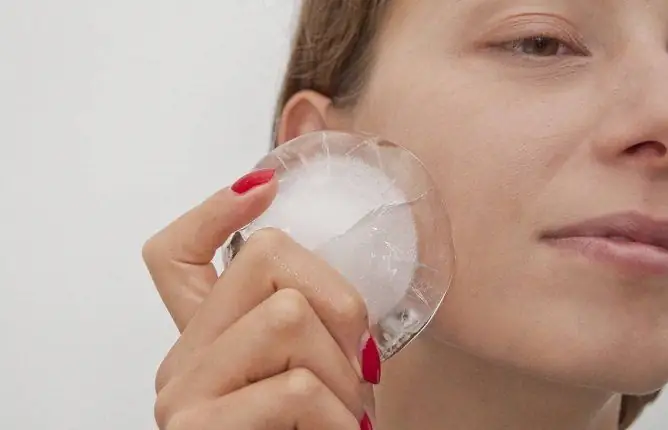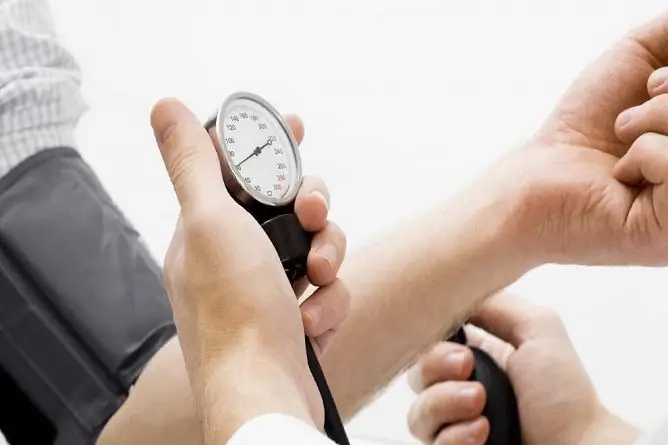- Author Rachel Wainwright [email protected].
- Public 2023-12-15 07:39.
- Last modified 2025-11-02 20:14.
Bruise after taking blood from a vein: why hematomas appear and what to do
The content of the article:
- Reasons for the appearance of hematoma
-
Treatment
- Dimexide
- Troxevasin
- Heparin ointment
- Hirudoven
- Folk remedies
- Prevention
- Video
Bruises after taking blood from a vein are often formed. In order to avoid the appearance of a hematoma, after the injection or testing, it is necessary to press the injection site and hold it for some time. This reduces the likelihood that blood will enter the subcutaneous tissue.

Bruising may form after taking blood from a vein
Reasons for the appearance of hematoma
The reason that a bruise remains at the puncture site after blood sampling may be:
| The reasons | Description |
| Puncture of a vein through and through | As a result, blood enters the tissues |
| Inept medical manipulation | The nurse cannot immediately enter the vein and injures the tissues, so only experienced medical personnel should take blood |
| Frequent manipulation of the same vein | Observed during long-term treatment that requires intravenous administration of drugs, or when it becomes necessary to donate blood again |
| Other reasons | Erroneous injection of an irritating substance under the skin, use of blunt needles, patient use of blood thinners |
Treatment
For the treatment of hematomas, external preparations are used, which improve blood circulation in the area of damage and accelerate healing.
Dimexide
Dimexide refers to anti-inflammatory drugs for external use that improve the course of metabolic processes in the focus of inflammation. Its active ingredient is dimethyl sulfoxide. It has a local anesthetic, antimicrobial and analgesic effect.

Dimexide must be diluted with water before use.
For treatment, you must mix one part of the drug and four parts of boiled chilled water. A piece of tissue is impregnated with a solution and applied to the bruise. Cover with polyethylene on top and leave for 7-8 hours.
Troxevasin
The main active ingredient of the gel is troxerutin. It increases vascular tone and reduces capillary permeability. The drug eliminates edema, reduces pain and improves tissue trophism.

Troxevasin treatment may last 3-7 days
Troxevasin gel is applied to the hematoma three times a day and rubbed lightly. Depending on the intensity of the hemorrhage, the treatment can last from 3 to 7 days.
Heparin ointment
The product contains sodium heparin and benzocaine. The drug has anti-inflammatory and local analgesic effects. It dissolves the formed hematomas and prevents the formation of blood clots.

Long-term use of Heparin ointment should be discussed with a doctor.
The ointment is applied to the damaged area with a thin layer 3-4 times a day (depending on how much the puncture site hurts). Treatment continues for 3-5 days.
In the presence of large and painful hematomas, applications with Heparin ointment can be done. To do this, the agent is applied to a napkin, which is fixed on the affected area. Treatment can last for three days, further use of the ointment must be agreed with the doctor.
Hirudoven

The ointment contains medicinal leech extract
The effect of the treatment is visible on days 2-3. You need to use the ointment until the hematoma disappears.
Folk remedies
If a bruise occurs after taking blood from a vein, or a lump or lump forms at the injection site, you can use traditional medicine methods:
- iodine mesh. A cotton swab is impregnated with iodine and stripes are applied to the injection site at a distance of about one centimeter. Such a remedy dissolves bumps and seals well. Do not apply iodine to the entire skin area without gaps, this can cause burns;
- soda solution. A tablespoon of soda is dissolved in a glass of water, then a piece of tissue is moistened in the solution and applied to the affected area. Cover with polyethylene on top, bandage and leave for an hour. The procedure is carried out twice a day until the hematoma disappears;
- clay compress. For treatment, you will need white or red clay powder. It is diluted to the thickness of sour cream and applied to the affected area. Wash off the product after two hours with warm water;
- cabbage leaf. It must be beaten off with the blunt side of a knife, smeared with honey and applied to the bruise. From above it is covered with cling film and left overnight. The procedure is carried out daily until the hematoma disappears;
- alcohol solution. A cotton pad soaked in 70% alcohol solution is applied to the area of the bruise. The compress is left for 2-3 hours. You can also use vodka for these purposes;
- hard cheese. A small slab of cheese is applied to the injury and secured with a bandage. This compress is left overnight. The procedure is repeated every evening until the result is achieved.
Prevention
In order to avoid the formation of a bruise or bump after an injection into a vein or testing, you must:
| Preventive actions | Description |
| Relaxation of the arm muscles | During the procedure, you need to relax the hand as much as possible, since with muscle tension, the likelihood of tissue damage increases significantly |
| Finding the Right Needle Size | To inject the drug, you must use a syringe with the appropriate needle diameter. If a large volume of fluid is injected with a thin needle, the likelihood of bruising at the injection site increases |
| Drug administration rate | The medicine must be injected smoothly and slowly to avoid leakage of the solution into the tissues surrounding the vein |
| Measures after the end of the procedure | After the injection, cotton wool soaked in alcohol is firmly pressed to the puncture site of the vein for 5-7 minutes |
This may mean that the vein is severely damaged and the assistance of a surgeon may be required.
Video
We offer for viewing a video on the topic of the article.

Anna Kozlova Medical journalist About the author
Education: Rostov State Medical University, specialty "General Medicine".
Found a mistake in the text? Select it and press Ctrl + Enter.






